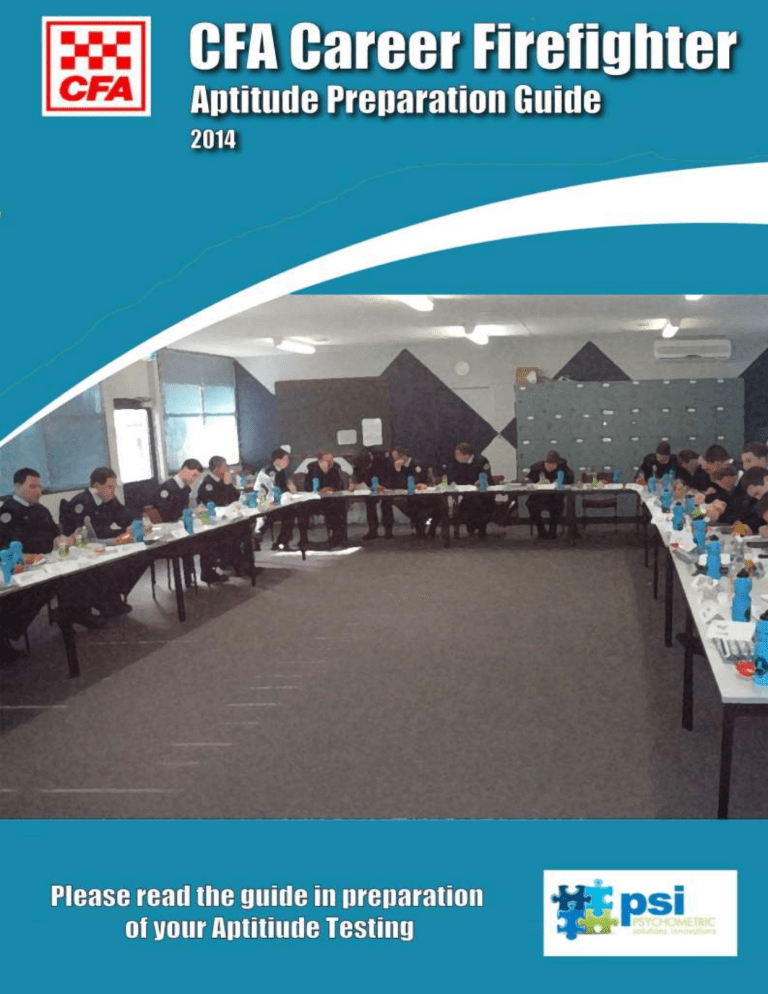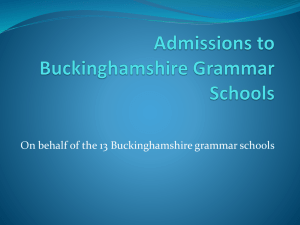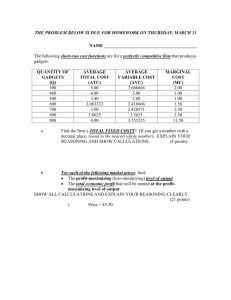Aptitude Preparation Guide (DOC 466k)

The Aptitude Tests also known as
‘Ability Tests’ are designed to measure a number of abilities and will be used during the Firefighter Recruitment Process.
Specifically, the tests will look at your ability to:
Think and reason using words and language (verbal reasoning)
Think and reason using numbers (numerical reasoning)
To visualise the relationship between moving parts in a space (mechanical reasoning ability)
The scores on the abilities tests are not used to rank people .
A very reasonable benchmark has been set and those who successfully make it through this phase of the assessment will have attained an overall score that is in the average range or better.
The results from the abilities tests will form a small part of the information that will be considered in each person’s application.
However, it should be noted that achieving the benchmark is necessary for an applicant to progress through to the next stage of the recruitment process.
Tips for Preparation and Taking Tests
Tips for Preparation
Do not leave your preparation until the night before the testing
–
Refresh your knowledge of arithmetic principals and English (a secondary school year book or
CD may be useful)
Read and examine numerical information, mechanical drawings etc.
Try practicing doing calculations without using a calculator
Get a good nights sleep the night before you sit the tests.
Tips for Taking Tests
The tests being used during the Firefighter Recruitment Process are made up of a mixture of easy, medium and difficult questions scattered throughout the test. Try to work quickly through the test to ensure that you get to attempt as many questions as possible
– remember, there could be some easier questions toward the end of the test so don’t waste too much time on difficult ones at the beginning .
Timed tests require you to work quickly through the questions, so don’t approach the test too casually .
Don’t spend too much time on any one question . If a question seems too difficult or timeconsuming, make a guess and move on to the other questions.
There is no penalty for getting a question wrong on these tests, so if you don’t know the answer, make a guess!
If you finish early, take the time to go back and check your answers.
Try not to leave any questions unanswered or blank
– remember there is no penalty for guessing and at least you have a chance of getting the question correct if you guess the answer rather than leaving it blank.
When you try out the following practice questions, make sure you do them all at the one time and see how you go getting them done as quickly as possible.
Remember, the practice questions to follow have a mix of easy and difficult questions, so you are not expected to get them all correct . You may also find that you are better at some types of questions (for example the verbal reasoning items) and not others (for example the numerical reasoning items). Don’t worry; it is quite normal for people to have strength in one area over another. That is why a variety of ability tests are being used. Generally, it will be your overall performance on the tests that counts . So if you don’t do well on one test, you will probably make up for it with your score on another.
Good Luck!
Sample of Verbal Reasoning Questions
A Verbal Reasoning Test looks at your ability to think and reason using words and language. Here are some sample questions.
1 .
The word most nearly OPPOSITE to PROCEED is: a) Progress b) Stop c) Steed d) Leap e) Divert
2. Find the two statements that together prove that:
ELISE ALWAYS SWIMS AT SORRENTO BEACH.
1) Elise is a keen swimmer and swims at the beach every weekend
2) Elise is a member of the Sorrento Lifesaving Club
3) Elise only ever swims with her friend Sue.
4) Elise has a boatshed at Sorrento beach.
5) Sue is only allowed to swim at Sorrento beach which she visits every weekend. a) 1&2 b) 1&4 c) 2&4 d) 3&5 e)1&5
3. The word most nearly the SAME as TIMELY is: a) Tardy b) Clock c) Sluggish d) Fast e) Punctual
4. Which pair of words BEST expresses the relationship between:
EAT – HUNGRY a) Cake
– Full b) Coke – Drink c) Drink – Thirsty d) Sit
– Stand e) Water - Bottle
Sample of Verbal Reasoning Questions (continued)
5. Four of the following words are alike in some way. What is the ODD WORD OUT ? a) Boat b) Motorcycle c) Car d) Bus e) Train
6.
Which of the following words DOES NOT mean the same as EXIT : a) Leave b) Depart c) Pursue d) Way Out e) Go Away
7. FREESTYLING is to SWIMMING as WALTZ is to: a) Rumba b) Walking c)Ballet d) Dancing e) Sport
8. Which of the following words DOES NOT mean the same as CAMOUFLAGE : a) Hide b) Recognise c) Disguise d) Conceal e) Cover
9. Find the two statements that together prove that:
RUPERT HAS MORE REAL ESTATE THAN KERRY.
1) Rupert has more real estate than everyone he went to school with.
2) The High Flier’s Tennis Club has very wealthy members.
3) Of everyone he plays tennis with, Rupert has the most real estate.
4)
Kerry is a member of the High Flier’s Tennis Club where Rupert often plays tennis.
5) Rupert did not go to school with Kerry, but plays tennis with him at the club. a) 1&5 b) 2&3 c) 2&4 d) 4&5 e) 3&5
10.
If you unscramble this sentence correctly, the fourth word will be.... need a indeed friend is a friend in a) need b) friend c) is d) indeed e) a
End of the Verbal Reasoning Practice Test.
Sample of Numerical Reasoning Questions
1. What is the missing number in this series?
3 7 11 15 ? 23
2. The numbers in the grid go together in a certain way.
What are the numbers that should be in the square marked by?
2 4 6
4 ? 8
6 8 ?
3. Edna’s chocolate fudge is a mixture of four parts Belgian chocolate to three parts coconut cream. If Edna needs to make 28 kilograms of fudge for the fair, how many kilograms of the coconut cream will she need?
4. What is the missing number in the following series?
5 7 11 17 ? 35
5. Graham had three times as many cars as Doug and twice as many as Steve, who got a new car for his birthday every year from the time he turned 18. If Steve is 20 years old, how many cars does Doug have?
6. Mr & Mrs Roberts are going on a picnic. They leave their home and travel at 60km per hour for 45 minutes and then stop to pick up some supplies from the store. The store is half way between their home and the picnic spot. How far is the picnic sport from the Roberts’ home?
Sample of Numerical Reasoning Questions (continued)
7. What are the missing numbers in this series?
2 4 8 16 32 ? ?
8. The numbers in the grid go together in a certain way. Some of them have been shaded or obscured to hide their numbers.
What is the number that should go in the square marked by the ?
6
♦
24
▲ 72 144
216 432 ?
9. In the lolly jar there are one third as many jelly-beans as there are smarties and four times as many strawberry-creams as jelly-beans. If I have 21 smarties, how many strawberrycreams do I have?
10. The newsagent paid the publisher $120 per hundred newspapers. He charged his customers for three newspapers, the same price as he had paid for five. What was the profit he made per hundred newspapers?
End of the Numerical Reasoning Practice Test.
Sample of Mechanical Reasoning Questions
The diagram above can be used to answer questions 1 to 3.
1. If I pull Lever A to the right, in which general direction will the rope move? a) Left b) Right c) Back & Forth d) The rope will not move.
2. If I pull Lever A down, pulling the rope with it, in which direction will Wheel B turn? a) Clockwise b) AntiClockwise c) Back and Forth d) The wheel won’t move
3. If I pull Lever A down, pulling the rope with it, which direction will Wheel C turn?
a) Clockwise b) AntiClockwise c) Back and Forth d) The wheel won’t move
Answer Sheet
Sample of
Reasoning
(continued)
The diagram above can be used to answer questions 4 & 5.
Mechanical
Questions
4. Wheels A & B move together as they are connected by the belt, as shown. The belt moves in the direction indicated by the arrow. When Wheel A turns anticlockwise (as shown by the arrow), Wheel B will move: a) Clockwise b) Anti-
Clockwise c) To and Fro d) The wheel won’t move
5. If I now push the belt so that Wheel A turns clockwise, in what direction will Wheel B move? a) Clockwise b) Anti-Clockwise c) To and Fro d) The wheel won’t move
End of the Mechanical Reasoning Practice Test.
Please use these answers to mark the practice questions; if you have any concerns or questions (or if there is anything you don’t understand) please contact PSI on (03) 9882 2903 or email info@psychsolutions.com.au
Verbal Reasoning
1. B
2. D
3. E
4. C
5. A
6. C
7. D
8. B
9. E
10. A
Numerical Reasoning
1. 19
2. 6 & 10
3. 12kg
4. 25
5. 2
6. 90km
7. 64 & 128
8. 864
9. 28
10. $80
Mechanical Reasoning
1. B
2. A
3. B
4. B
5. A








